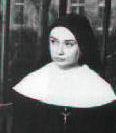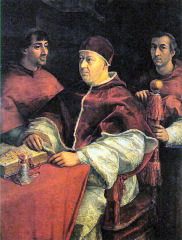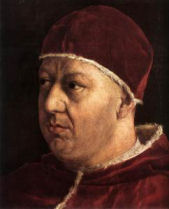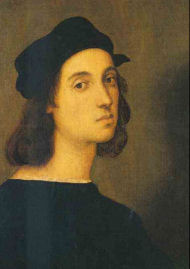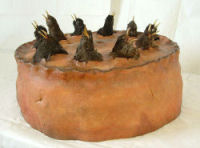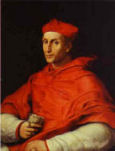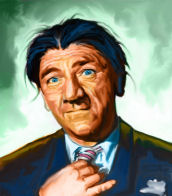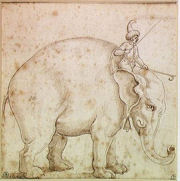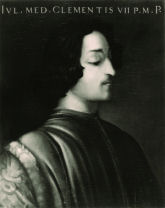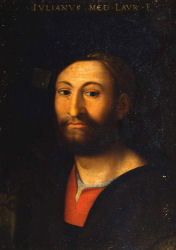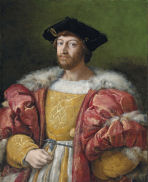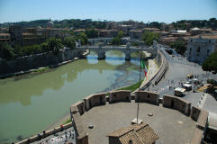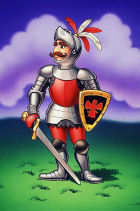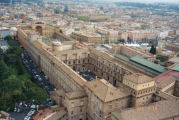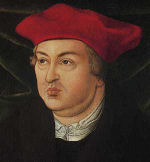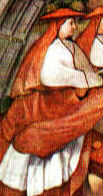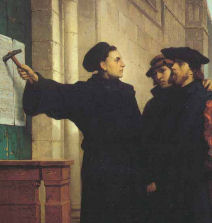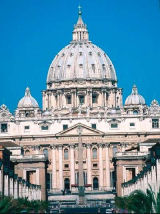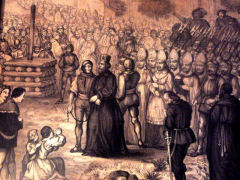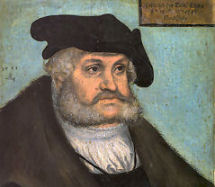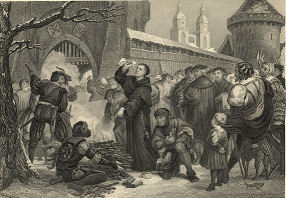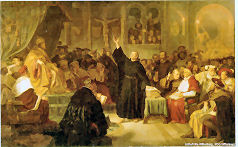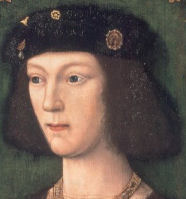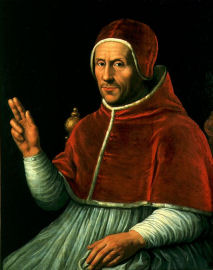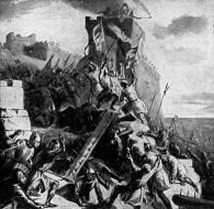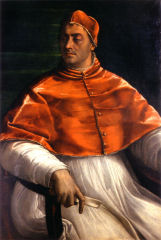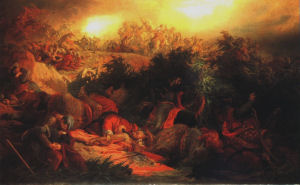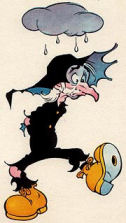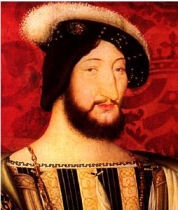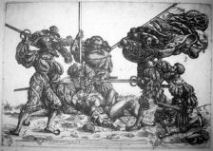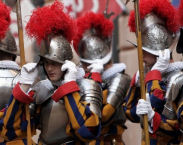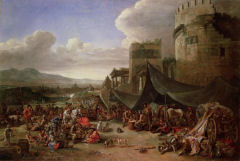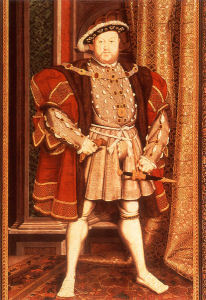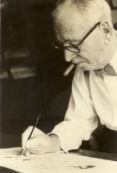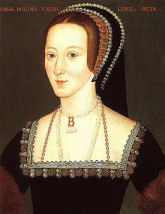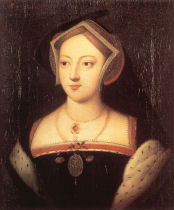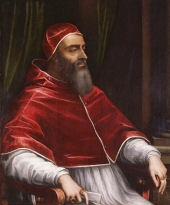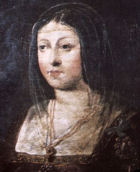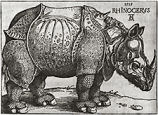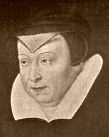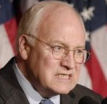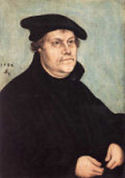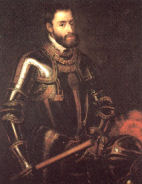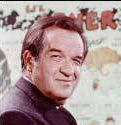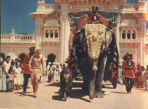Chapter 17: The Medici Popes Find the Protestants Revolting
The Leonine Age
When Pope Julius II died in 1513, Europe had been thoroughly Christian for centuries. Jews and Muslims remained scattered about,[1] but every ruler was loyal either to Rome or to the eastern Church. Rome’s hegemony was far greater; the Greeks had been marginalized by the Turks. A well-defined orthodoxy was strictly enforced by the Inquisition. Europeans confessed one creed, and the supremacy of the Holy Father in Rome was fundamental. What most Christians knew about the Bible and the creed came from frescoes on the walls of their churches and sermons delivered by the priests. A few Bibles had been printed and distributed in Germany, but laymen were discouraged from reading scripture.
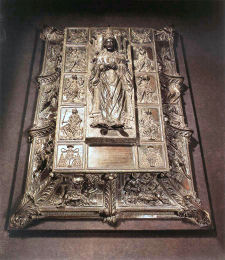
In contrast to the driven white-bearded warrior, Julius II, the next pope was the clean-shaven easy-going Giovanni de’ Medici, who had spent twenty-four of his thirty-seven years as a cardinal.[2] His father was Lorenzo the Magnificent, the patron of the Renaissance, and his mother was an Orsini. The young cardinal had been captured by the French during Pope Julius’s war, but he somehow escaped. He had led the Medicis since his older brother Piero died in 1503. He ruled the Florentine city-state while simultaneously holding twenty-seven separate papal appointments, including the abbacy of Monte Cassino and the office of papal notary. He was not related to even one pope, and he was not ordained, but his was still the most impressive résumé[3] for the job. The young man took the name of Leo X.
He was a funny-looking guy. Raphael’s portrait, despite the fact that the papal vestments hide all but his hands and his face, is stunning. Barbara W. Tuchman described his appearance thus: “Leo was short, fat and flabby, with a head too heavy and legs too puny for his body.”[4] He had Barney Rubble’s build, but his face looked more like Fred’s. Fortunately, his demeanor was nothing like the irascible Flintstone’s; everyone found him amiable, polished, and intelligent. Paul Sarpi, the historian of the Council of Trent, attributed to him “such charming manners that he would have been a perfect man if he had had some knowledge of religion and greater inclination to piety.”Religion indeed played a minor role in this pope’s life. During his teen years Leo had studied theology, but as pope he seldom showed much interest in the subject. Perhaps his red hat had provoked ridicule from his fellow scholars, and he soured on it. Although he freely indulged inclinations peculiar for a Vicar of Christ, he left behind no brood of bastards scheming to obtain pontifically sponsored sinecures. In fact, no sexual scandals are associated with his entire career. There was no secret “Wilma.” If he ever had an affair, it must have been discreet.[5] In Italy in the cinquecinto this was quite unusual.
Here is a short list of Pope Leo’s diverse interests.
• He loved to hunt and fish. These activities were forbidden to clerics by canon law, but who was going to reprimand the pope? As many as eighteen cardinals and sixty to seventy hounds joined Leo’s hunting parties at his luxurious hunting villa in Magliana. Despite his love of the chase, the pontiff explicitly forbade clerics in Portugal from engaging in the sport. • He held literature, even pagan literature, in the highest esteem.• Ditto for art. Painting excited him more than sculpture. He was a great patron of Raphael. Michelangelo he assigned the design of the Medici Chapel of Florence’s Church of San Lorenzo.
• Pope Leo devoted huge sums to the new Basilica of St. Peter in the Vatican. When its architect, Donato Bramante, died in 1514, the pontiff named Raphael to the post.
• Leo generously funded numerous charitable causes with the Church’s money.
• He demonstrated a sincere appreciation for his papal retinue, which was four times as large as his predecessor’s staff.• He reveled in pageantry and celebrations. His was the legendary era of sixty-five-course dinners, which might include solid gold disposable plates, courses of parrot’s tongues, pies loaded with blackbirds or nightingales, peacock’s tails, or enormous pastries containing live children ready to put on a show.
• Leo patronized the theater. He thoroughly enjoyed plays that would be R-rated even by twenty-first century standards. He eventually made a cardinal of one of those risqué playwrights, Bernardo Dovizi, better known as Bibbiena. • The pope was a fan of slapstick and buffoonery. He much preferred Curly to Shemp. On his staff was a monk who allegedly could swallow a pigeon whole and eat forty eggs at one sitting.• Gambling at cards was a favored pastime in the Vatican apartments, and more than matchsticks were at stake.
• The pope’s favorite pet was Hanno the white elephant, a gift from the King of Portugal.[6] Later the Muslim writer Leo Africanus was presented to the pope as a present from the Knights of Rhodes.• Leo performed quite a few dazzling tricks in the diplomatic field. Sovereigns continually complained that he misled them. He failed to see why a treaty with one party precluded him from negotiating with that person’s enemy.
• His Holiness lured Gian Paolo Bagnoni, the dictator of Perugia, to Rome with a promise of safe-conduct. When Bagnoni arrived in town, the pope had him beheaded. Several notables fell for the same safe-conduct ruse. “Fool me once, shame on – shame on you. Fool me – you can't get fooled again.”[7]
• The Fifth Lateran Council proffered suggestions for reforming the Church, but Leo’s attention was focused elsewhere.
Once a Medici, …
Carving out an enduring legacy for the Medici family was a high papal priority. Pope Leo immediately attested to the legitimacy of his cousin Julius’s birth.[8] After validating the transparently false claim that Julius’s parents were secretly married,[9] he named Julius cardinal and vice-chancellor of the Church. Julius became Leo’s most trusted advisor and also ruled Florence and its holdings throughout Leo’s pontificate. His adept performance was widely applauded.Pope Leo immediately made a cardinal of his twenty-one-year-old nephew Innocent Civò, grandson of Pope Innocent VIII. In 1517 two more nephews were deemed worthy of the red hat. His brother’s son Hippolytus became a cardinal a little later.
Leo advanced his family’s fortunes in the lay sector as well. He arranged the marriage of his younger brother Julian to the aunt of the French queen. The tab for the newlyweds’ party set the papacy back approximately 30 percent of a year’s income. The pontiff also ceded the couple the proceeds from the wealthy areas of Parma, Piacenza, and Modena, the last of which Pope Leo purchased for them. The pope appointed Julian Gonfalonier of the Church. King Francis of France also bestowed a duchy on Julian. Unfortunately, the young man died before the second anniversary of his nuptials. His Holiness invested his nephew Lorenzo with the duchy of Urbino, long controlled by the Della Roveres. The pope not only deposed the sitting duke, Francesco Maria della Rovere; he also excommunicated the poor fellow. His family naturally looked askance at this turn of events. The pontiff spent several years, a considerable papal fortune, and valuable political capital fighting for Lorenzo’s rights. When the war for Urbino faltered, he called on Christian Europe to aid him. Pope Leo later arranged for Lorenzo’s marriage to Madeleine de la Tour d’Auvergne,[10] a member of the French royal family. He provided this happy couple with gifts equivalent to 60 percent of the total annual revenue of the Papal States.“Deficits Don’t Matter”[11]
Bookkeepers and auditors might have noticed that the aforementioned activities tended to be rather costly. Indeed, Pope Leo made even the Borgias look penurious. No pope before or since has played in his league. Deficit spending in the early sixteenth century was problematic. Use of the printing press had spread, but not the notion of paper money. Since people expected to be paid in gold or silver, Pope Leo was forced to devise some really imaginative coin tricks.
• The number of posts for sale by the Church was expanded greatly. For example, the “porzioni di ripa” were increased from 141 to 612. In these transactions the purchaser bought from the pope the assignment of overseeing a section of one of the Tiber’s banks. For this imaginary service the pope annually paid him a designated salary. It amounted to a loan with no repayment terms. The sales generated a sum equal to six times the annual revenue of all the Papal States!• A new order of religious knights, the Cavalieri di San Pietro, was created. All 401 members coughed up one thousand ducats as dues.
• Pope Leo offered to support Charles Hapsburg’s candidacy for Holy Roman Emperor in return for a payment of 100,000 ducats, roughly one-fifth of the papacy’s annual income. If you want to dance, you have to pay the poper, er, piper.
• “Loan followed loan. Not only were the tapestries of the Vatican and the silver plate given as securities, but ecclesiastical benefices, the gems of the papal tiara and the rich statues of the saints were put in pawn. Sometimes the pope paid 20 percent for sums of ten thousand ducats and over.”[12] That’s a 20 percent vigorish for terms as short as six months. Payment of interest was considered usury under canon law, but the Holy Father called the premium payment a gift. Leo’s deals created a boom in the banking sector. Among the creditors were many well-heeled cardinals. Several lived to regret their loans.• The papal milliner made certain that there was no shortage of red hats, but anyone not named Medici who aspired to one needed deep pockets. June 26, 1517, was a red-letter day; Pope Leo named thirty-one new cardinals! The list consisted of a few relatives and friends, representatives of the most powerful Italian families, and relatives of rich aristocrats willing to pay top ducat. This flurry of appointments also ensured that subsequent conclaves would be dominated by the Medicis.
• The pope could not print money, but nothing prevented that new papal printing press from churning out indulgences. The first set helped fund the new Basilica of St. Peter’s. A rate chart set the number of years in purgatory excused for each ducat or florin contributed. The second round of papal indulgences in 1515 helped the twenty-four-year-old Albrecht of Brandenburg, the Archbishop of Magdeburg. Albrecht needed to feed his PayPal account enough to cover a bishopric and a second archbishopric that he had ordered from the pope’s website, www.indulgeme.com. A Dominican monk named John Tetzel helped move these papal papers on his behalf. Tetzel’s pitch often included the phrase “As soon as the coin in the coffer rings, the soul from purgatory springs.” Pope Leo later distanced himself from this hard sell, but he also excommunicated anyone challenging his right to issue indulgences. Tetzel’s campaign in Germany was the flashpoint for the Protestant revolution, or “reformation” as heathens[13] have described it. • Taxes were beneath Pope Leo. “The States of the Church were unquestionably less burdened with imposts at that moment than any other; and Rome, as compared with other cities, was equally fortunate as to amount of taxation.”[14]• Paris de Grassis, the pope’s master of ceremonies, suspected His Holiness of manufacturing a crisis over the “Petrucci conspiracy,” the alleged assassination plot involving disaffected cardinals. Pope Leo accused Cardinal Petrucci of contriving a scheme to pay the pope’s surgeon to inject poison into His Holiness’s nether orifice during a procedure to relieve the distress from his mountainous hemorrhoids. Petrucci was in fact arrested, tortured, and, after the inevitable confession, executed.[15] However, several of the co-conspirators escaped with hefty fines. Cardinal Raffaele Riario, who as a young man had been imprisoned in 1478 for the Pazzi conspiracy, was forced to pay a sum equal to 30 percent of the papacy’s total annual income just to retain his red hat and the head on which it rested.
The Monkish Squabble
On October 31, 1517, an Augustinian monk named Martin Luther posted ninety-five theses on the door of a church in Wittenburg, a university town in northern Germany. The door was commonly used as a bulletin board by the monks, so the event was not as dramatic as sometimes imagined. Similar acts were not uncommon; since the time of the rebellious councils in Constance and Basel, clerical intellectuals at universities had occasionally voiced opinions inconsistent with Rome’s dictates. The tone of Luther’s theses was not as strident as, for example, the Declaration of Independence. Luther still believed in the supremacy of the pope.[16] Most theses were pleas on behalf of the have-nots of Germany for sympathy from the powers that be (and have) in Rome. If he had stopped at seventy or eighty theses, the controversy might have blown over. However, a few got a little personal. For example, #86 asks, “Why does not the pope, whose riches are at this day more ample than those of the wealthiest of the wealthy, build the one Basilica of St. Peter with his own money, rather than that of poor believers?” This was preposterous. The largest and most elegant edifice in European history would surely have required not just Pope Leo’s wealth but also that of one or two cardinals. Besides, if Leo had earmarked all of his cash for the basilica, who would provide for all the unemployed buffoons and dog handlers? At first the pope did not take Luther very seriously. Why would he? The SOP for dealing with such dissidents had been established by Pope Innocent III in the 1200’s. Luther’s monastic order would be pressured to remind him how his bread got buttered. If he did not come to his senses, the pope would denounce his writings as heretical. At that point he would either recant or be introduced to the local Inquisitor. A tale or two featuring the roasted flesh of John Huss or some other rebellious intellectual might be recounted for his benefit. If worse came to worst, Rome could launch a crusade and pressure the ruling class into squashing the rebellion using any means necessary, even if a few (or a few thousand) faithful became “collateral damage” in the process. For centuries this approach had suppressed nearly every discordant concept, or at least its public manifestation. Luther’s case, however, posed subtle new difficulties. He could resist papal pressure due to his distance from Rome and strong political connections, particularly Frederick the Wise, the Elector of Saxony. He could use the printing press to communicate with anyone who could read. The influence of his ideas was therefore not limited to the areas that he visited. Although the pope could (and did) order that Luther’s books be burned, torching every single copy was difficult, and more could be printed. After Luther parried his initial thrusts, Pope Leo got serious. On June 15, 1520, he issued a bull declaring that forty-one of the ninety-five theses contained errors. He allowed the monk sixty days to retract them. Luther publicly burned the bull. After the pope excommunicated him, Luther kept a low profile. The young Hapsburg emperor, Charles V, was the ultimate civil authority in all of Germany; the ball was in his court. European rulers had consistently enforced the popes’ edicts against heresy, a responsibility willingly assumed as the price for papal endorsement of their divine right to rule.In 1521 the emperor convened the Diet of Worms. This synod was certainly a turning point in Church history, but no one can fault Sr. Mary Immaculata for never mentioning it. The name itself would have doubtless generated endless snickering and pantomiming, leading inevitably to a rendition of “Great Green Gobs,” one of our favorite songs.
Luther, to whom Charles had provided a safe-conduct, appeared in person at Worms. He refused to recant his writings unless someone could refute them using scripture and reasoning. Charles added the imperial ban to that of the Church. At the close of the diet, however, the emperor listened to political rather than religious advisors. Ignoring the precedent of Emperor Sigismund’s double-cross of John Huss in Constance, Charles allowed Luther to return to Wittenburg as long as he promised not to preach along the way.[17]After the diet Emperor Charles left Germany for Spain to concentrate his attention on Spain and Italy. He left Germany’s fate to his brother, Ferdinand. At Pope Leo’s request the emperor soon brought his troops into Italy and ousted the French.
Meanwhile, King Henry VIII of England had published a pamphlet defending the Church’s use of seven sacraments, rather than the two accepted by Luther. Pope Leo was so impressed with this treatise that he granted – at no charge! – to the king and his successors use of the title, Fidei Defensor, Defender of the Faith. British monarchs still claim this ironic title, and English coins still include the letters F.D.On December 1, 1521, at the zenith of his popularity the pope unexpectedly expired[18] just short of his forty-sixth birthday. Leo personified Renaissance poping: live fast, die young, and leave … not a beautiful corpse but a mountain of unpaid debts. At the end of the Leonine Age Luther was in hiding, the emperor was well on his way to purging Italy of the hated French, Rome’s economy was booming, and the Eternal City was brimming with talented artists and writers.
Unfortunately, Rome was also full of bankers and cardinals who had waited a little too long to call in their loans. The papacy was hopelessly in the red, and the papal coffers contained nothing more substantial than cobwebs. Usurious lenders faced bankruptcy because of their willingness to underwrite the pope’s extravagant projects and lifestyle.
Sauerkraut Pizza, Anyone?
The conclave to choose Pope Leo X’s successor was split between the supporters of the King of France, Francis I, and his great rival, Emperor Charles V, who still controlled both Germany and Spain. The most influential cardinal was Julius de’ Medici, Leo’s cousin and step-brother. One evening a cardinal suggested that they order takeout from the fashionable new Roman trattoria, Götterdämmerung’s, which served its hops-based wine with a frothy white head in a strangely shaped chalice known as a stein. The next morning everyone had a headache and a vague recollection that a sixty-two-year-old named Adrian Florisz Dedel had been elected pope. A theologian from Utrecht, Dedel had been the emperor’s tutor and was then employed as his regent in Spain. His most attractive attribute was probably his absence. All present had been eliminated from consideration by the third round of Cardinal Puff.[19] Cardinal Dedel had never even been to Italy, and it took him until August 29, 1522, to reach the Eternal City. By the time that he was officially enthroned as Pope Adrian VI, almost nine months had elapsed since Pope Leo’s demise. The new pope immediately began slashing expenses. He reduced or eliminated subsidies for many artists and musicians. Gone were the opulent banquets, pageants, and hunting trips. The Italian term for Pope Adrian’s type is “guastafeste,” which means “party-pooper.”The pontiff published a book in which he opined that popes could be wrong even in matters of faith and even claimed that Pope John XXII, $crooge McPope of Avignon, had been a heretic when he denied Beatific Vision. Adrian also published a “confession” that acknowledged wantonness, abuses, and excesses among the clergy.
When Pope Adrian expired after only twelve and one-half months, no cardinal mourned him overmuch. The dour Dutchman’s passing was welcome news to most Romans. He left such a bad taste in everyone’s mouth that the papacy was reserved for Italians for the next 455 years! Some have noted that the pontificates of reform-minded popes in this era seem much shorter than the terms of less scrupulous ones with a flair for high living, ruthless suppression of dissent, and nepotism. I wonder how Sr. Mary Immaculata would have dismissed this observation.The most important event of Adrian’s papacy was a negative. The pontiff had begged the European powers to defend Rhodes, a critical nexus for Mediterranean commerce, from takeover by the Sultan. His pleas went unheeded, and the headquarters of the Knights of St. John fell into Turkish hands on October 24, 1522.
Pope Btfsplk I
The conclave of 1523 featured four factions – the Medicis, the Colonnas, the French, and the Spanish. Logrolling occupied the cardinals for the better part of two months, during which time they were deprived – at least in theory – of contact with the outside world, light, and in the end, food more substantive than bread and water. The Colonnas grew so upset at the duplicity of their erstwhile French allies that they sided with Julius de’ Medici, who had already enticed the imperial party into supporting him. On November 18, 1523, a second Medici was elected pope with the name Clement VII, the moniker used by the first pope of the Avignon obedience, Robert of Geneva.Clement was a known quantity, extremely competent in every field. “He spoke with equal knowledge of his subject, whether that were philosophy and theology, or mechanics and hydraulic architecture. In all affairs he displayed extraordinary acuteness; the most perplexing questions were unraveled, the most difficult circumstances penetrated to the very bottom by his extreme sagacity.”[20] He had even led the papal army. The Romans could not have been happier, but their glee was short-lived. Pope Clement’s eleven-year pontificate coincided with ineffable catastrophes for Rome and the Church.
• The Turks captured Hungary. Their way to Vienna was clear.• Hundreds of thousands of European Christians were captured and enslaved by Muslim raiders from the sea.
• The Protestant revolt spread rapidly from Germany to neighboring countries.
• Rome fell twice to Christian troops and suffered its worst sack ever.
• England and its colonies separated from the Roman Church over one man’s divorce.
Perhaps a century of outrageous papal comportment rendered disaster inevitable, and everything just hit the fan during Clement’s pontificate. Perhaps two Medici popes in such a short period was tempting fate. Faced with emergencies, Pope Clement, as accomplished as he was, seemed incapable of devious tricks, and he never mastered the diplomatic juggling so skillfully employed by his cousin, Leo X. Perhaps he was just the wrong man for the times, and a more artful diplomat could have kept a lid on events. Or maybe after assuming the helm of the Church he just became, like Joe Btfsplk,[21] a lovable jinx. Pope Clement initially concentrated on the ceaseless strife between King Francis and Emperor Charles. He attempted some diplomatic double-dealing as perfected by his cousin, but this maneuvers required expert misdirection, and Clement lacked Leo’s charming manner. His imperious countenance also inspired much less trust than Leo’s earthy look. Pope Clement negotiated deals with Charles, but his heart was obviously with Francis.In 1525 the emperor vanquished the French at Pavia and even captured King Francis, with whom Clement had inked a secret pact the previous year. After Charles’s triumph the pope reluctantly aligned with the empire by signing a treaty with Naples, but he shortly thereafter also entered into the League of Cognac, formed to thwart Charles’s incursions in northern Italy.
Meanwhile, Cardinal Pompeo Colonna, the vice-chancellor of the Church, came to regret his support of the Medicis. He assembled an army and conquered Rome on September 20, 1526. A Roman cardinal seized Rome from the pope through military force! The pontiff dared not leave Castel Sant’Angelo even when Colonna’s troops ransacked the Vatican. To make peace, the pope promised to support the emperor. After Colonna ended the siege, however, the pope reneged and, in fact, deposed the cardinal.[22] Clement’s duplicitous treatment of Colonna probably contributed to the Duke of Ferrara’s decision to throw his support behind the imperial forces. This removed the last significant barrier between Rome and twenty thousand or so imperial troops, which were a mixture of men loyal to the Duke of Bourbon and German mercenaries known as the Landsknechts, many of whom were Lutherans. Their paymaster had neglected them for some time. They took it upon themselves[23] to attack Rome, largely because it seemed their best hope of lining their pockets. They were right; the city was both wealthy and poorly defended.
Pope Clement challenged the Roman faithful to take up arms, but no more than five hundred responded. Well-trained, well-armed French troops and German mercenaries outnumbered these ragtag volunteers by forty to one! The pope trusted that God was on their side, but he suspected that more would be needed. Then Clement remembered the Lethal Four-Card Fist.[24] During Leo X’s pontificate, Gunga,[25] Hanno’s mahout, had taught Cardinal de’ Medici a valuable self-defense technique handed down to him by Masubob the Heathen in the pristine jungles of India. A skillful practitioner could fling four playing cards arranged in parallel between his fingers so as to lay low four unsuspecting adversaries in one swift motion and then, before anyone realized what had transpired, reload his fist for the next wave of assailants. If sixteenth-century Rome was well-stocked with anything, it was gaming equipment. Pope Clement charged his consistory with combing each of the city’s seven hills for playing cards. The cardinals scrounged up enough to provide each stalwart defender with two decks – twenty-six death-dealing fistfuls (plus the jokers, which were reserved for hara-kiri). Time was short; the pope trained his men as well as he could, but there was little opportunity to practice before the enemy beset them.From his palazzo’s roof Pope Clement watched the stalwart Roman force assume positions opposite the invaders. Each man’s left palm held one deck in the mechanic’s grip. The deadly right hand was loaded with four pasteboards. Time after time a Roman’s arm would rise and then swiftly fall. Ahimè, the cards nearly always fluttered harmlessly to the ground. Even from his distant perch the Holy Father readily discerned the difficulty. Frantically he cupped his hands around his mouth and shouted at the top of his voice, “Your wrist! You’ve got to snap your wrist!” It was to no avail; the plaintive pontiff was well beyond the defenders’ earshot.
On the steps of St. Peter’s the Swiss Guards held the invaders off long enough for Pope Clement and fourteen cardinals to take refuge in Castel Sant’Angelo. The invaders then spent eight full days in every manner of ignominious conduct. “The Sack of Rome” usually refers to the one by the Christian army of 1527 rather than any by the so-called barbarians of the first millennium. Roughly 80 percent of the citizenry abandoned Rome to the imperial troops. Those who stayed probably regretted it. Four thousand or so Romans perished. There was absolutely no limit to the rapine. Protestant and Catholic soldiers were equally culpable. There are several strong contenders, but this may rank as the most disgraceful event in Christian history.Pope Clement was confined to his castle/prison for seven months. He eventually came to terms with Emperor Charles, who was genuinely appalled at his troops’ behavior and therefore rather merciful in his bargaining. On February 24, 1530, Pope Clement crowned Charles as emperor, and Charles kissed the pope’s feet. Everyone knew which gesture carried more meaning. In fact, Charles was the last Holy Roman Emperor who asked the pope to crown him.
Second Verse, Same as the First
Pope Clement’s English problem was reminiscent of the issue faced by Pope Julius II a decade or two earlier. This time King Henry VIII had the hots for Anne Boleyn, but two impediments prevented their union. First, the king was already hitched to Catherine of Aragon. The Tudors had persuaded Julius to annul Catherine’s marriage to Henry’s deceased brother Arthur on the grounds that it had never been consummated. Reprising that trick was hopeless; Catherine had been pregnant at least seven times in this marriage, although the royal couple had only one surviving daughter[26] to show for all of that sack time. The king asked the pope to void his marriage to Catherine on the grounds that Pope Julius had been tricked into annulling his brother’s marriage. What effrontery – attempting to persuade a pope to disavow trickery! Clement would have none of it. Catherine of Aragon was Charles V’s aunt, and the pope was wary of the emperor’s wrath. He appointed Cardinal Rubo Goldberghi to concoct a framework for resolving the situation. Both the king and queen were represented by lawyers and clergy in official hearings. Secret decretals were issued. A commission established criteria for a subsequent determination of the original bull’s validity. The Spanish produced a papal brief alleged to be independent of Pope Julius’s bull. The queen insisted throughout that everyone had been truthful during the first inquiry. The meetings and the litigation dragged on for six years! As often seemed to be the case in Clement’s papacy, nothing was accomplished in the end. A second problem was Henry’s previous torrid (and commonly known) affair with Anne Boleyn’s sister Mary. By the standards of the day marrying Anne would be incestuous. Pope Clement granted Henry a dispensation, but it was worthless unless Henry could rid himself of his Spanish ball and chain.In 1533 Anne Boleyn became pregnant. This could be the king’s heir! The desperate monarch persuaded the English clergy to declare as a group that they would thenceforward submit matters to the king rather than the pope. Henry proclaimed the Archbishop of Canterbury the spiritual head of the Church of England, and he persuaded Archbishop Thomas Cranmer to grant him an immediate divorce. Although forced to leave the court, Catherine at least retained her head. Two decades later her daughter Mary became Queen of England.
Pope Clement wasted no time in dropping the X-bomb on King Henry,[27] but at that range the pope’s weapon of last resort had precious little effect. Shaming Charles V into sailing across the Channel to defend the honor of his aunt and his faith was beyond the pope’s skills. Clement watched helplessly as the pontifically appointed Defender of the Faith established a rival Church.Pope Clement died in September of 1534 at the age of fifty-six, evidently from an Amanita Muscaria mushroom. Perhaps he was poisoned by an enemy, or perhaps, in a seldom cited corollary to Murphy’s Law, Pope Btfsplk died because everything that possibly could go wrong had already occurred.
[1] At Torquemada’s urging King Ferdinand and Queen Isabella in 1492 ordered some 200,000 Jews to leave Spain. Spain had expelled its Muslims a short time earlier. Portugal banished its Jews a few years later, but tens of thousands converted, at least formally, rather than depart. Many exiled Jews emigrated to Turkey, where the Islamic Sultan warmly welcomed them.
[2] Giovanni de’ Medici is not the all-time Doogie Howser of the consistory. As pope he named as cardinal Alfonso de Portugal, who had graced the planet for only eight years, two months, and seven days.
[3] Ordinarily the cardinals would have considered Medici’s youth a disqualifier. They usually hedged their bets by electing pontiffs with short life expectancies. However, Giovanni’s health was suspect; he had to be carried to the conclave.
[4] Tuchman, op. cit., p. 107.
[5] Guicciardini’s explanation is that he swung from the other side of the plate. De Rosa, op. cit., pp. 113-114.
[6] King Manuel also gave the pope a rhinoceros. No rhino had set foot in Europe since the salad days of the Roman Empire. Inspired by Pliny the Elder’s comment that the rhinoceros and the elephant were deadly enemies, Pope Leo intended to stage an epic confrontation between Hanno and his purported nemesis in the papal gardens. However, in 1517 the ship transporting the rhino sank off the coast of Genoa. Its carcass was recovered and stuffed. The clash of the two pachyderms never took place, so Hanno remained the undisputed champion of the superheavyweight division of the pope’s menagerie.
[7] President George W. Bush in Tennessee in 2002.
[8] Julius’s father, Julian, was assassinated in the cathedral in Florence, the victim of the “Pazzi Conspiracy.” Leo’s father, Lorenzo, barely escaped. Lorenzo then adopted Julius.
[9] At the time bastards were not allowed to become cardinals.
[10] Their daughter, Catherine de’ Medici, became queen of France.
[11] Vice-president Dick Cheney, quoted by Ron Suskind in The Price of Loyalty, Simon and Schuster, 2004, p. 291.
[12] Schaff citing von Schulte, who in turn cited Sanuto and other contemporary writers. History of the Christian Church, William B. Eedermans, 1960, Vol. VI.
[13] Sr. Mary Immaculata seldom drew distinctions among Jews, Muslims, Hindus, Mormons, atheists, agnostics, and Protestants. They were all non-Catholics or just plain heathens.
[14] Von Ranke, op. cit., Vol. I, p. 281.
[15] The cardinal was strangled. It was evidently beneath the dignity of anyone at the Vatican to perform this action, so they hired a moor to do it.
[16] After Luther discovered that the papacy’s historical claims had been based on the forged Pseudo-Isidorian Decretals, he favored a council to address papal abuses. Later, Luther abruptly recanted his claim that ecumenical councils were infallible. Thereafter the only sources he acknowledged were scripture and reason.
[17] Charles’s own story is a remarkable one. He enjoyed great success in battle against both the French and the Turks. In 1556, at the age of fifty-six, in extreme pain from the gout that had plagued him for years, Charles retired to a secluded Spanish monastery in Yuste. He ardently supported the papacy, and he often expressed regret that he had not eliminated Luther at Worms. He died after a year and a half of cloistered life.
[18] Poison was suspected; John-Peter Pham has written that recently discovered documents bolster this claim. Heirs of the Fisherman, Oxford University Press, 2004, pp. 31-32.
[19] The rules to this game are posted at http://www.brewthis.com/drinking-games/The-Real-Cardinal-Puff-rules.html.
[20] Von Ranke, op.cit., Vol. 1, p. 70.
[21] Al Capp pronounced Joe’s surname by sticking out his tongue and blowing a “raspberry.”
[22] Hardly ever has a cardinal been deposed. The pope later reinstated him.
[23] Their titular leader was Charles, the Duke of Bourbon, who was slain in the fighting at Castel Sant’Angelo, allegedly by a crossbow bolt shot by Benvenuto Cellini. In addition to commanding the pope’s artillery, Cellini also designed all of the pope’s coinage and much of his metal statuary. Cellini helped Pope Clement pay his ransom by melting down the papal tiara. Hector Berlioz composed an opera about Cellini’s statue of Perseus.
[24] The Lethal Four-Card Fist is also a terrific conjuring effect invented by Ricky Jay. Cards as Weapons, Darien House, New York, 1977, pp. 57-58.
[25] Gunga was also a recurring character on The Buster Brown Show in the fifties.
[26] It seems unlikely that the difficulty in producing a male heir resulted from any deficiency in King Henry’s own equipment. If his suit of plate mail on display in the Royal Armouries of the Tower of London actually fit him, he must have been endowed with a very impressive package. http://www.12go.co.uk/pictures.cfm?i=2194
[27] England was not, however, placed under interdict despite (or maybe because of) the fact that the English clergy went along with Henry’s plan.
 | |
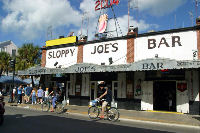 | |
Bankable Bar Bets
$ King Ferdinand and Queen Isabella expelled thousands of Jews from Spain. Many ended up in Turkey, where they were welcomed by the Islamic Sultan.
$ Giovanni de’ Medici was only thirteen when he became a cardinal. Twenty-four years later he became Pope Leo X and appointed an eight-year-old cardinal.
$ Although it was forbidden by canon law for clerics to hunt, Pope Leo often organized large hunting parties.
$ Pope Leo attended several risqué plays and even named one of the playwrights a cardinal.
$ The King of Portugal gave Pope Leo a white elephant. He also shipped the pontiff a rhinoceros, but it died en route. The pope planned to stage a battle between the two beasts in the Vatican gardens.
$ Pope Leo affirmed the transparent lie that his cousin Julius’s birth was legitimate.
$ Pope Leo borrowed money at rates as high as 20 percent for a six-month period.
$ Pope Leo named thirty-one cardinals on one day.
$ Pope Leo established a rate card for indulgences.
$ A group of cardinals tried to poison Pope Leo by paying his doctor to administer poison up the pope’s rectum during an operation on the pontifical hemorrhoids.
$ Pope Adrian VI published a book that claimed that popes could be wrong in matters of faith and that Pope John XXII had been a heretic.
$ Cardinal Colonna put together an army, conquered Rome, and sacked the Vatican in 1526.
$ In 1527 a Christian army took the city of Rome and sacked it for eight days.
$ Pope Clement VII was unable to leave Castel Sant’Angelo for seven months when Emperor Charles V invaded Italy.
$ The pope’s legal inquiry into King Henry VIII’s request for a divorce from Catherine of Aragon lasted for six years.
$ The pope bestowed the title Defender of the Faith on King Henry VIII of England. Although Henry was later excommunicated for setting up a rival Church, English monarchs still use the title.
$ Pope Clement VII died after eating an Amanita Muscaria mushroom.
